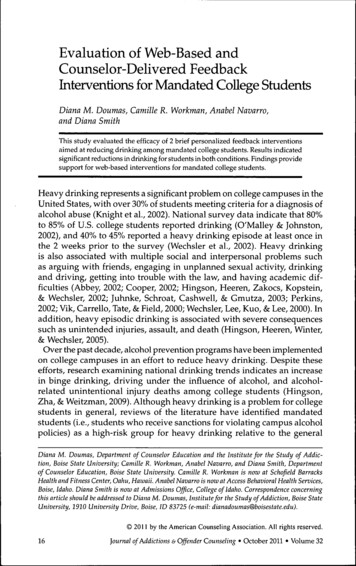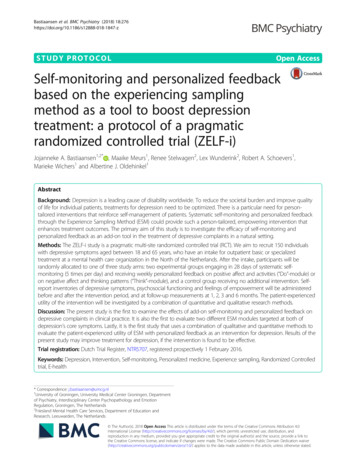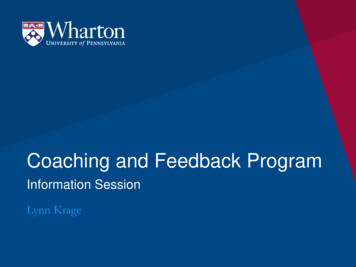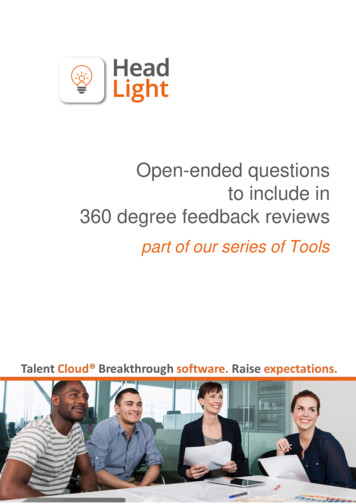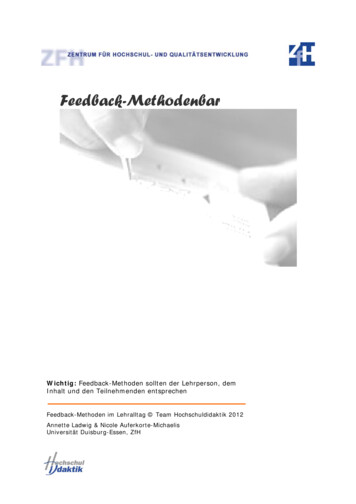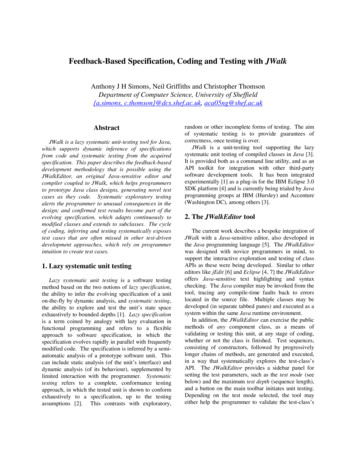
Transcription
Feedback-Based Specification, Coding and Testing with JWalkAnthony J H Simons, Neil Griffiths and Christopher ThomsonDepartment of Computer Science, University of Sheffield{a.simons, c.thomson}@dcs.shef.ac.uk, aca05ng@shef.ac.ukAbstractJWalk is a lazy systematic unit-testing tool for Java,which supports dynamic inference of specificationsfrom code and systematic testing from the acquiredspecification. This paper describes the feedback-baseddevelopment methodology that is possible using theJWalkEditor, an original Java-sensitive editor andcompiler coupled to JWalk, which helps programmersto prototype Java class designs, generating novel testcases as they code. Systematic exploratory testingalerts the programmer to unusual consequences in thedesign; and confirmed test results become part of theevolving specification, which adapts continuously tomodified classes and extends to subclasses. The cycleof coding, inferring and testing systematically exposestest cases that are often missed in other test-drivendevelopment approaches, which rely on programmerintuition to create test cases.1. Lazy systematic unit testingLazy systematic unit testing is a software testingmethod based on the two notions of lazy specification,the ability to infer the evolving specification of a uniton-the-fly by dynamic analysis, and systematic testing,the ability to explore and test the unit’s state spaceexhaustively to bounded depths [1]. Lazy specificationis a term coined by analogy with lazy evaluation infunctional programming and refers to a flexibleapproach to software specification, in which thespecification evolves rapidly in parallel with frequentlymodified code. The specification is inferred by a semiautomatic analysis of a prototype software unit. Thiscan include static analysis (of the unit’s interface) anddynamic analysis (of its behaviour), supplemented bylimited interaction with the programmer. Systematictesting refers to a complete, conformance testingapproach, in which the tested unit is shown to conformexhaustively to a specification, up to the testingassumptions [2]. This contrasts with exploratory,random or other incomplete forms of testing. The aimof systematic testing is to provide guarantees ofcorrectness, once testing is over.JWalk is a unit-testing tool supporting the lazysystematic unit testing of compiled classes in Java [3].It is provided both as a command line utility, and as anAPI toolkit for integration with other third-partysoftware development tools. It has been integratedexperimentally [1] as a plug-in for the IBM Eclipse 3.0SDK platform [4] and is currently being trialed by Javaprogramming groups at IBM (Hursley) and Accenture(Washington DC), among others [3].2. The JWalkEditor toolThe current work describes a bespoke integration ofJWalk with a Java-sensitive editor, also developed inthe Java programming language [5]. The JWalkEditorwas designed with novice programmers in mind, tosupport the interactive exploration and testing of classAPIs as these were being developed. Similar to othereditors like jEdit [6] and Eclipse [4, 7] the JWalkEditoroffers Java-sensitive text highlighting and syntaxchecking. The Java compiler may be invoked from thetool, tracing any compile-time faults back to errorslocated in the source file. Multiple classes may bedeveloped (in separate tabbed panes) and executed as asystem within the same Java runtime environment.In addition, the JWalkEditor can exercise the publicmethods of any component class, as a means ofvalidating or testing this unit, at any stage of coding,whether or not the class is finished. Test sequences,consisting of constructors, followed by progressivelylonger chains of methods, are generated and executed,in a way that systematically explores the test-class’sAPI. The JWalkEditor provides a sidebar panel forsetting the test parameters, such as the test mode (seebelow) and the maximum test depth (sequence length),and a button on the main toolbar initiates unit testing.Depending on the test mode selected, the tool mayeither help the programmer to validate the test-class’s
Figure 1. JWalkEditor, exploring the API of a LibraryBook during the validation phaseobservable behaviour, by presenting the results ofexploratory sequences for inspection, or formally testthe class’s behaviour with respect to a test oracle,which is created according to the lazy specificationmethod described above.During validation, the tool may explore all methodprotocols (all interleaved orderings of methods), allalgebraic constructions (all interleaved state-modifyingmethods, followed by every observer-method) or alldesign states and transitions (the switch-1 switch-ncover). This can be viewed as exploring the test-classaccording to different models of state abstraction. Thefirst mode can be compared roughly with JCrasher [8]and Rostra’s [9] method-states and the second modewith Rostra’s modifier-states (except that JWalk is notrandom, but deterministic in its selection of arguments,and detects state-modification empirically, rather thanby signature analysis). The design state mode isoriginal to JWalk and utilizes the Cartesian product ofstate predicate observations as indicators of qualitativestates [1]. The results of exploring the test-class arepresented to the programmer for validation, as sets ofobservations, organized by sequence length, in awindow containing a tabbed pane for each set (fig. 1).During formal testing (as opposed to exploratoryvalidation), the tool verifies the outcomes of the sametests semi-automatically against predictions made by atest oracle. The oracle is gradually populated withknown correct and incorrect results, as the programmeraccepts or rejects key test sequences, using a dialogthat presents one sequence at a time. By making amixture of opportunistic and conservative assumptions,JWalk predicts further test outcomes, given the initialresults. For example, void methods typically yield noresult (but may raise exceptions); and sequences withobserver-methods in their prefix are predicted to yieldthe same result as shorter sequences without theobservers. When used incrementally, JWalk predictsover 90% of test outcomes (amortized over test depth;see section 5), allowing significantly large numbers ofpaths to be tested [1] for minimal human intervention.3. Feedback-based development methodThe JWalkEditor supports a novel paradigm forspecification, coding and testing, which contrasts bothwith formal development, and with more recent agileapproaches. Formal software development methods
have an initial specification stage, in which the designis specified in a formal language, such as Z or VDM, orusing a state-based tool, such as SDL or Statemate.This approach supports fully automated and systematictest generation, using the specification to inform theselection of test cases and determine coverage; but hasthe extra overhead of developing a specification in thefirst place; and runs the risk that the software may laterevolve independently.More recently, agile development methods, such asextreme programming (XP), have advocated a “testfirst” approach [10] in which programmers create testsbefore writing software, or “test-driven development”[11] in which testing and coding are inter-dependentactivities. The tests take the place of a formalspecification, encoding the properties that the softwaremust eventually satisfy. This has the advantage that thespecification (viz. the test-set) is executable, but thedisadvantage that it is developed in a piecemeal way,according to the fallible insights of the programmer,who must constantly update the test-set if theproduction code is modified (arguably no easier thanmaintaining the validity of a formal specification w.r.t.evolving code).The JWalkEditor offers a new approach, in whichthe programmer is entirely free to prototype the code asthey wish; and the tool supports this by “growing” anassociated specification, which evolves in step with thecode. The specification is in the form of the savedoracle, generated during interactive testing. At first,the tool presents key test cases to the programmer forconfirmation (state-modifying sequences, followed bysingle observations); but later it uses saved results topredict further test outcomes by rule [1]. Whenever anovel test outcome is observed (because it breaks aprediction, or contradicts a previously-saved result),the tool requests another confirmation. Otherwise, itassumes that the existing prediction is still valid (whichholds in practice most of the time – see the discussionbelow; and [1]). In this way, JWalk incrementallybuilds a bounded, exhaustive model of an algebraicspecification. It then generates a more abstract, highlevel state-based specification, exploring the testclass’s state space, using state-predicate methods in theclass’s interface to identify any interesting states.JWalk acquires the state cover test set (reaching allstates) and from this may generate the transition cover,the switch-1 cover (all method pairs), the switch-2cover (all method triples), starting from each state.But the tool also offers something else that is quitevaluable, namely an on-the-fly validation of the latestdesign choices. When the programmer makes a changeto the code in the editor, JWalk may immediatelyexplore the consequences of the latest modification,systematically revealing the effects of novelinterleavings of methods and exposing corner-cases(such as testing nullops, or all interleaved observermethods for their unexpected side-effects), which theprogrammer might not have fully considered. Thisexperience is somewhat similar to that of modelvalidation from a partial specification, the approachadopted by model-checking tools such as Alloy [12].For this reason, it is relevant to consider theJWalkEditor also as a kind of specification tool, whichhelps the programmer to determine dynamically thedesired design for the class under development. Wecall this a “feedback-based” approach to specification,since the programmer may immediately see theconsequences of particular design choices.The cyclic development methodology is extremelyhabitable, because it capitalizes on what the differentparties do best. Programmers are motivated mostly bythe creativity of writing new code, and the gratificationof seeing this execute, rather than by the process ofcreating a watertight specification. On the other hand,automated tools are better at performing systematictasks, such as exploring all method combinations, statesand transitions. The process of building confidence inthe design is also on a human scale, since the toolpresents information gradually to the programmer,showing first the obvious cases, then only presentinginteresting novel cases, which could not be predicted.4. An example of class developmentTo illustrate the experience of developing code inthe JWalkEditor, the following example is given, as anindication of how a typical apprentice programmermight approach the task of providing two classes,related by inheritance. The first class, a LibraryBook,has the following structure:public class LibraryBook {private String borrower;public LibraryBook();public void issue(String);public void discharge();public String getBorrower();public Boolean isOnLoan();}Initially, the programmer codes issue and dischargeto set and clear the borrower attribute, and ensures thatisOnLoan returns true when borrower ! null. Next, aprotocol-walk is performed, which reveals interestingobservations: sequences that repeat issue, or dischargeare apparently acceptable! The programmer considersthis, deciding that it is legitimate for discharge to be a
nullop when the LibraryBook is not on loan, but thatsequences repeating issue violate the business rules ofthe library. So, he returns to the editor, and inserts aprecondition into the issue method, which raises anexception if an attempt is made to issue theLibraryBook to more than one borrower. Focusingnow on state-modifying sequences, the programmerinitiates an algebra-walk (see fig. 1) to confirm that theprecondition correctly raises the exception. After this,he may explore algebraic constructions to greaterdepth, to be assured that it is possible to discharge andthen issue the LibaryBook to a different borrower.At this point, the observed behaviour seemsacceptable, so the programmer switches to the algebratest mode, in order to build the oracle, and confirmseach presented observation as correct. In order toverify the class more thoroughly, he then selects thestate-test mode, in which JWalk identifies two abstractdesign states, the Default state and the OnLoan state,determined from the false and true outcomes of thestate predicate isOnLoan. JWalk computes the statecover, and tests all interleaved method sequences,starting in each of these states, to the desired depth. Ifthe depth parameter is 3, this is equivalent to testing theswitch-2 cover [13], which according to Chow’s testingtheory is sufficient to guarantee the correct behaviourof even a poorly implemented test class, containingredundant states and duplicated paths of length 2.Subsequently, the programmer wishes to extend thebehaviour of the LibraryBook, in a subclass calledReservableBook. This has the structure:public class ReservableBookextends LibraryBook {private String requester;public ReservableBook();public void reserve(String);public void cancel();public String getRequester();public Boolean isReserved();}Let us assume that the programmer expects tovalidate combinations of the state-modifying methodsreserve, cancel and observers getRequester, isReservedin a similar style to the above. What he may not haveanticipated is that methods inherited from LibraryBookinteract with ReservableBook’s methods in unexpectedways (he has “tunnel vision”, a common fault).In algebra-test mode, JWalk imports the existingoracle for the LibraryBook superclass, using this as thebasis for the new oracle. The tool exercises reserveand cancel as expected, but does not re-present any ofthe old mutation sequences that involved only issue anddischarge, which it can predict from the old oracle.However, previously unseen sequences that interleavereserve and cancel with the inherited state-modifyingmethod sequences containing issue and discharge arepresented. This is a considerable improvement overregression testing with saved test-sets in JUnit, since itinterleaves local and inherited methods in all possiblecombinations, rather than simply applying thesuperclass’s test-set as a whole to the subclass, whichhas been proven to hide introduced faults [2].At depth 2, the algebra-test interleaves reserve andissue. At depth 3, getBorrower and getRequesterobserve that a book can be reserved by borrower-A andthen issued to borrower-B, which violates the library’sbusiness rules again. The programmer is able to rejectthis outcome, which is logged in the oracle as a knownfault. Furthermore, issuing the book should cancel theprior reservation (and does not). At the end of the testcycle, all known faults are listed in a summary.Returning to the editor, the programmer decides tooverride issue in ReservableBook to ensure that a bookis only loaned (a) if it was not reserved, or (b) if thenew borrower is the requester who reserved it; and thenthe prior reservation should be cancelled.Recompiling the test-class, he re-runs the algebra-test,and this time is only presented with the cases involvingthe modified code, which he confirms as correct.Finally, to demonstrate JWalk’s ability to detectinteresting high-level states, the state-test mode may beselected. JWalk will detect four abstract design states:Default, OnLoan, Reserved and OnLoan&Reserved,named automatically after the boolean product of thepredicates isOnLoan and isReserved (which yield falseand true in four combinations). JWalk will determinehow to reach each of these states and may be directedto verify the switch-n cover. In this test mode, JWalkwill predict most test results, either from previouslyseen cases (during the algebra-test) or by rule-basedprediction, identifying equivalence-classes of testsequences, which all map onto canonical sequenceswith no observers in the prefix. Some longer unseensequences that start in the more distant states (e.g.OnLoan&Reserved) will request new confirmations.5. Experimental EvaluationThe effectiveness of this cyclic feedback-basedcoding, specification and testing method can bemeasured in several ways. Firstly, the number of newtest-confirmations in each cycle is small, compared tothe overall number of automated tests. Table 1 showsthe amortized cost of confirmations over test cycles ofincreasing depth, for the algebra-test mode (a1, a2,a3), followed by the state-test mode (s1, s2, s3). The
rows marked “con” denote new manual confirmationsper depth cycle, while the rows marked “pre” denoteautomated retests and predictions, which increasinglydominate the state-test results. The level of automationrises from 40% to well over 90%. But even ifconfirmations are not amortized over test cycles, theystill form a small fraction of overall tests executed:20/138 or 14% for the LibraryBook, and 167/1816 or9% for the ReservableBook.Table 1. Amortized user interaction costsTest classLibBk conLibBk preResBk conResBk 831649With practice, a programmer can confirm each keytest-result in 2-3 seconds, building the oracle at around25 test cases per minute. This compares favourablyagainst manual testing methods, in which programmerstake much longer to think up suitable test cases. Table2 shows how long it took two developers to test “thetransition cover, plus argument equivalence partitions”[14] both manually “man”, and using the tool “jwk” forthe same examples. The time column indicates min.sectaken to develop and conduct tests.Table 2. Speed and adequacy of testingTest classLibBk manResBk manLibBk jwkResBk 11.0020.000.300.46The test coverage adequacy Adq is expressed as afraction of effective test cases TE over ideal test cases Tthat were determined by inspection. The redundanttests TR indicate wasted effort, showing how the manualtester over-compensated, creating duplicated test cases.JWalk’s coverage was nearly total (100% effective onstate-based criteria, but missing 4 partitions on inputcriteria: JWalk does not yet perform full equivalencepartition testing).The power of JWalk comes from its predictive rules,especially the predictions about sequence equivalenceclasses (the observer-prefix elimination case); this is astrong conservative assumption, which always holds(side-effect-free invocations are detected empirically).A weaker opportunistic assumption, such as wherestack.pop() is expected to return void, may not alwayshold, and early testing may fail to spot the missingprecondition on empty stacks. Violated assumptionsare usually detected by longer test-sequences in thenext cycle, such as the unexpected result: stack.size() -1. The same principle applies to missing overrides(the case of issue, above), or rare cases of double-faultsthat happen to map onto the correct result. Testing todepth k 1 usually exposes unwanted statesmasquerading as expected states in the previous cycle,c.f. Chow’s method [13]. Opportunistic assumptionsare so useful in cutting down the number of casespresented to the programmer, that it would beimpractical to do without them. Further examples ofthe test-coverage of JWalk may be found in [14].Acknowledgement: Thanks are due to Arne-MichaelToersel (at TaicPart ’07) for test cases used to developthe JWalk beta-2 revision.6. References[1] A. J. H. Simons, “JWalk: a tool for lazy systematic testingof Java classes, by design introspection and user interaction”,J. Auto. Softw. Eng., 14 (4), 2007, 369-418.[2] A. J. H. Simons, “A theory of regression testing forbehaviourally compatible object types”, Softw. Test., Verif.Reliab., 8(2), 2006, 133-156.[3] A. J. H. Sim
JWalk with a Java-sensitive editor, also developed in the Java programming language [5]. The JWalkEditor was designed with novice programmers in mind, to support the interactive exploration and testing of class APIs as these were being developed. Similar to other editors .
